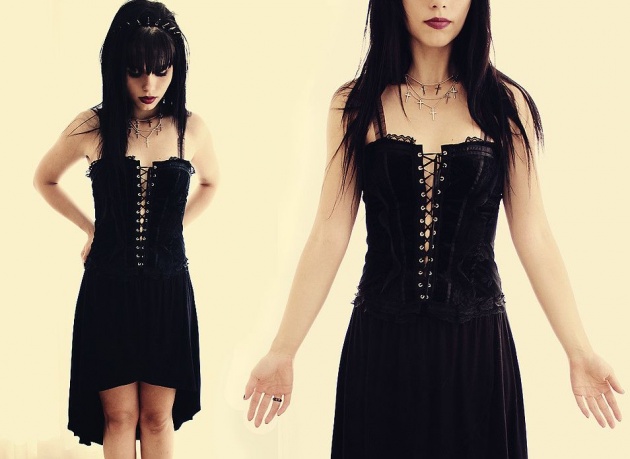Gothic fashion is a clothing style marked by conspicuously dark, mysterious, antiquated and 



 features. It is worn by members of the Goth subculture. A dark, sometimes morbid fashion and style of dress,[1] typical gothic fashion includes a pale complexion with colored black hair, black lips and black clothes.[1] Both male and female goths wear dark eyeliner and dark fingernail polish. Styles are often borrowed from the punk fashion, Victorians and Elizabethans.[1] Goth fashion is sometimes confused with heavy metal fashion and emo fashion.
features. It is worn by members of the Goth subculture. A dark, sometimes morbid fashion and style of dress,[1] typical gothic fashion includes a pale complexion with colored black hair, black lips and black clothes.[1] Both male and female goths wear dark eyeliner and dark fingernail polish. Styles are often borrowed from the punk fashion, Victorians and Elizabethans.[1] Goth fashion is sometimes confused with heavy metal fashion and emo fashion.
Characteristics[edit]
A male and female Goth couple.
Cintra Wilson declares that "The origins of contemporary goth style are found in the Victorian cult of mourning."[2] Valerie Steele is an expert in the history of the style.[2]
Goth fashion can be recognized by its stark black clothing. Ted Polhemus described goth fashion as a "profusion of black velvets, lace, fishnets and leather tinged with scarlet or purple, accessorized with tightly laced corsets, gloves, precarious stilettos and silver jewelry depicting religious or occult themes".[3] Researcher Maxim W. Furek noted "Goth is a revolt against the slick fashions of the 1970s disco era and a protest against the colorful pastels and extravagance of the 1980s. Black hair, dark clothing and pale complexions provide the basic look of the Goth Dresser. One can paradoxically argue that the Goth look is one of deliberate overstatement as just a casual look at the heavy emphasis on dark flowing capes, ruffled cuffs, pale makeup and dyed hair demonstrate a modern-day version of late Victorian excess.[4]
Nancy Kilpatrick's Goth Bible: A Compendium for the Darkly Inclined defines "poseur" for the goth scene as follows:"goth wannabes, usually young kids going through a goth phase who do not hold to goth sensibilities but want to be part of the goth crowd...". Kilpatrick contributor "Daoine O'" denigrates poseur goths as "Batbabies" whose clothing is bought at [mall store] Hot Topic with their parents' money.[5]
Icons[edit]
One female role model is Theda Bara, the 1910s femme fatale known for her dark eyeshadow.[6][7] Musidora, Bela Lugosi,[8] Bettie Page,Morticia Addams,[7] Nico, David Bowie,[1] Lux Interior,[1] Dave Vanian,[9] Robert Smith[10] are also style icons. Siouxsie Sioux was particularly influential on the dress style of the Gothic rock scene; Paul Morley of NME described Siouxsie and the Banshees' 1980 gig at Futurama: "[Siouxsie was] modeling her newest outfit, the one that will influence how all the girls dress over the next few months. About half the girls at Leeds had used Sioux as a basis for their appearance, hair to ankle."[11] The 1990s saw a surge of US-based gothic fashion designers, many of whom continue to evolve the style through the current day. Style magazines such as Gothic Beauty have given repeat features to a select few gothic fashion designers who began their labels in the 1990s, such as Kambriel, Rose Mortem, and Tyler Ondine of Heavy Red. [12]
Variations[edit]
Haute Goth[edit]
Vibeke Stene, the former female lead vocalist of Gothic metal bandTristania.
In 1977, Karl Lagerfeld hosted the Soirée Moratoire Noir party, specifying "tenue tragique noire absolument obligatoire" (black tragic dress absolutely required).[13] The event included elements associated with leatherman style.[13]
Goth fashion has a reciprocal relationship with the fashion world. In the later part of the first decade of the 21st century, designers such asAlexander McQueen,[2][14][15] Rick Owens,[15] Gareth Pugh, Ann Demeulemeester, Philipp Plein, Hedi Slimane, John Richmond, John Galliano,[2][14][15] Olivier Theyskens[15][16] and Yohji Yamamoto[15] brought elements of goth to runways.[2] This was described as "Haute Goth" by Cintra Wilson in the New York Times.[2] Thierry Mugler, Claude Montana, Jean Paul Gaultier and Christian Lacroix have also been associated with a gothic style.[14] In Spring 2004, Riccardo Tisci, Jean Paul Gaultier, Raf Simons and Stefano Pilati dressed their models as "glamorous ghouls dressed in form-fitting suits and coal-tinted cocktail dresses".[16] Swedish designer Helena Horstedt and jewelry artist Hanna Hedman also practice a goth aesthetic.[17]
Gothic lolita[edit]
Gothic lolita, sometimes shortened to gosu rori (ゴスロリ?) in Japanese, is a combination of Gothic and lolita fashions.[citation needed] The fashion originated in the late 1990s in Harajuku.[18]
Gothic lolita fashion is characterized by darker make-up and clothing.[19] Red lipstick and smokey or neatly defined eyes, created using black eyeliner, are typical styles, although as with all lolita sub-styles the look remains fairly natural.[20] Though Gothic make-up has been associated with a white-powdered face, this is usually considered poor taste within the (largely Japanese) lolita fashion scene.



